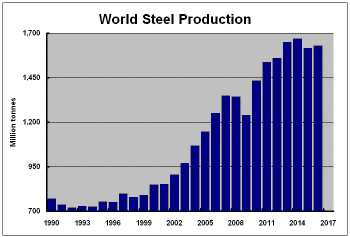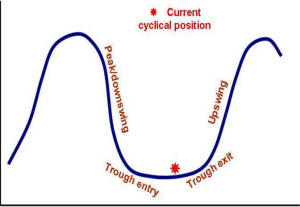The Current View
Growth in demand for raw materials peaked in late 2010. Since then, supply growth has generally outstripped demand leading to inventory rebuilding or spare production capacity. With the risk of shortages greatly reduced, prices lost their risk premia and have been tending toward marginal production costs to rebalance markets.
The missing ingredient for a move to the next phase of the cycle is an acceleration in global output growth which boosts raw material demand by enough to stabilise metal inventories or utilise excess capacity.
The PortfolioDirect cyclical
guideposts suggest that the best possible macroeconomic circumstances for
the resources sector will involve a sequence of upward revisions to
global growth forecasts, the term structure of metal prices once again
reflecting rising near term shortages, a weakening US dollar, strong money
supply growth rates and positive Chinese growth momentum. None of the five guideposts is "set to green"
(after the most recent adjustments in December 2016) suggesting the sector remains confined
to near the bottom of the cycle.

Has Anything Changed? - Updated View
From mid 2014, the metal market cyclical position was characterised as ‘Trough Entry’ with all but one of the PortfolioDirect cyclical guideposts - the international policy stance - flashing ‘red’ to indicate the absence of support.
Through February 2016, the first signs of cyclical improvement in nearly two years started to emerge. The metal price term structure reflected some moderate tightening in market conditions and the guidepost indicator was upgraded to ‘amber’ pending confirmation of further movement in this direction.
As of early December 2016, the Chinese growth momentum indicator was also upgraded to amber reflecting some slight improvement in the reading from the manufacturing sector purchasing managers index. Offsetting this benefit, to some extent, the policy stance indicator has been downgraded from green to amber. While monetary conditions remain broadly supportive, the momentum of growth in money supply is slackening while further constraints on fiscal, regulatory and trade regimes become evident.
Market Balance Statistics Show Demand Weakness
Updated data about the balance of metal markets suggest less buoyant
conditions than many companies had been extrapolating to justify themselves
as investments.
The International Copper Study Group (ICSG) has reported
that copper usage grew by 426,000 tonnes or 1.8% in 2016.

The group's preliminary assessment of the market outcome for the year suggests that demand for copper globally grew at a slower pace in 2015 and 2016 than in any of the prior five years.
The modest growth rates in copper usage are consistent with a macro backdrop of relatively steady and slow global output growth.
The acceleration in global growth which is typically a necessary condition for strengthening growth in raw material demand has been absent.
Increases in supply have been outstripping subdued demand outcomes, according to the ICSG analysis.
While copper metal demand has risen by 581,000 tonnes over the past two years, metal contained in mine output has risen 1.7 million tonnes, according to the government sponsored industry body.
Metal output, though, has increased by a lesser 526,000 tonnes preventing a strong buildup in metal inventories but setting in train a negative rebalancing of the market.
The ICSG has estimated that mine output could rise by as much as 2.4 million tonnes or 12% by 2019. Above average demand growth will be needed to absorb such an addition to supplies.
Against the currently anticipated macro backdrop, potential demand growth appears insufficient to keep the market near balance raising the likelihood of inventory accumulation over the next several years with adverse consequences for metal prices.
The International Lead Zinc Study Group (ILZSG) has also
published its initial estimates of market outcomes in 2016.

The ILZSG data convey a similar picture for zinc as the ICSG data portray for copper.
After a contraction in global zinc demand in 2015, usage increased in 2016 but the net gain over the last two years of only 214,000 tonnes was equivalent to an increase of only 1.6%.
Several high profile mine closures in Australia and Ireland as well as production cutbacks by industry leader Glencore have resulted in the zinc market experiencing heavier supply side constraints than in copper.
The supply side restraint has led many commentators to highlight zinc exposed companies as superior alternatives within the mining investment space.
Zinc mine output was little changed in 2016 but declined by 300,000 tonnes over the past two years, according to the study group estimates. At the same time, metal production rose by 178,000 tonnes or 1.3%.
Some slight tightening in market balances has occurred
with the ILZSG now estimating that industry inventories at the end of 2016
were equivalent to 5.2 weeks of 2016 consumption. This was the
tightest balance since the end of 2008 but still well above outcomes in 2006
and 2007 when prices were around their cyclically strongest levels. 
Zinc mine output growth in coming years could be enough to outstrip demand growth amid the currently anticipated macro conditions.
The zinc market rebalancing will not be as dramatic as in the case of copper but enough to impart an upward bias to inventories, seemingly placing a lid on recently strong prices.
Importantly, if such a scenario eventuates, some companies will have lost the advantage of being able to claim that zinc prices are 'going through the roof' in soliciting investors.
Copper and zinc market outcomes are consistent with previously released data from the World Steel Association showing steel production (and, consequently, iron ore needs) having peaked although remaining at near record levels.



